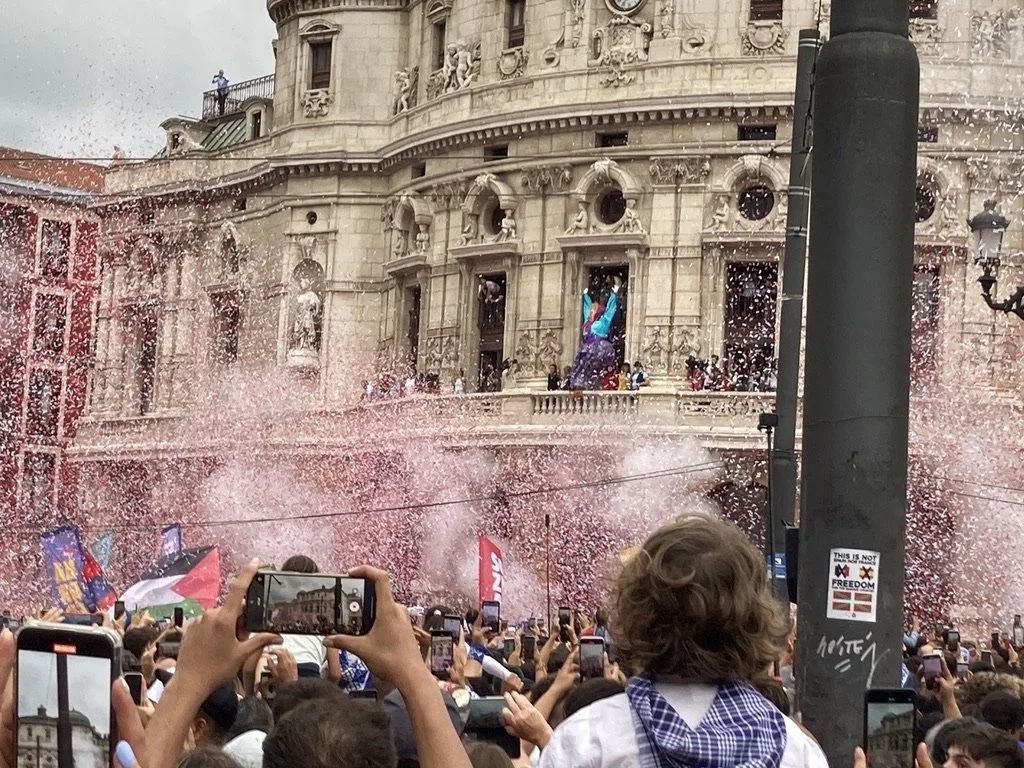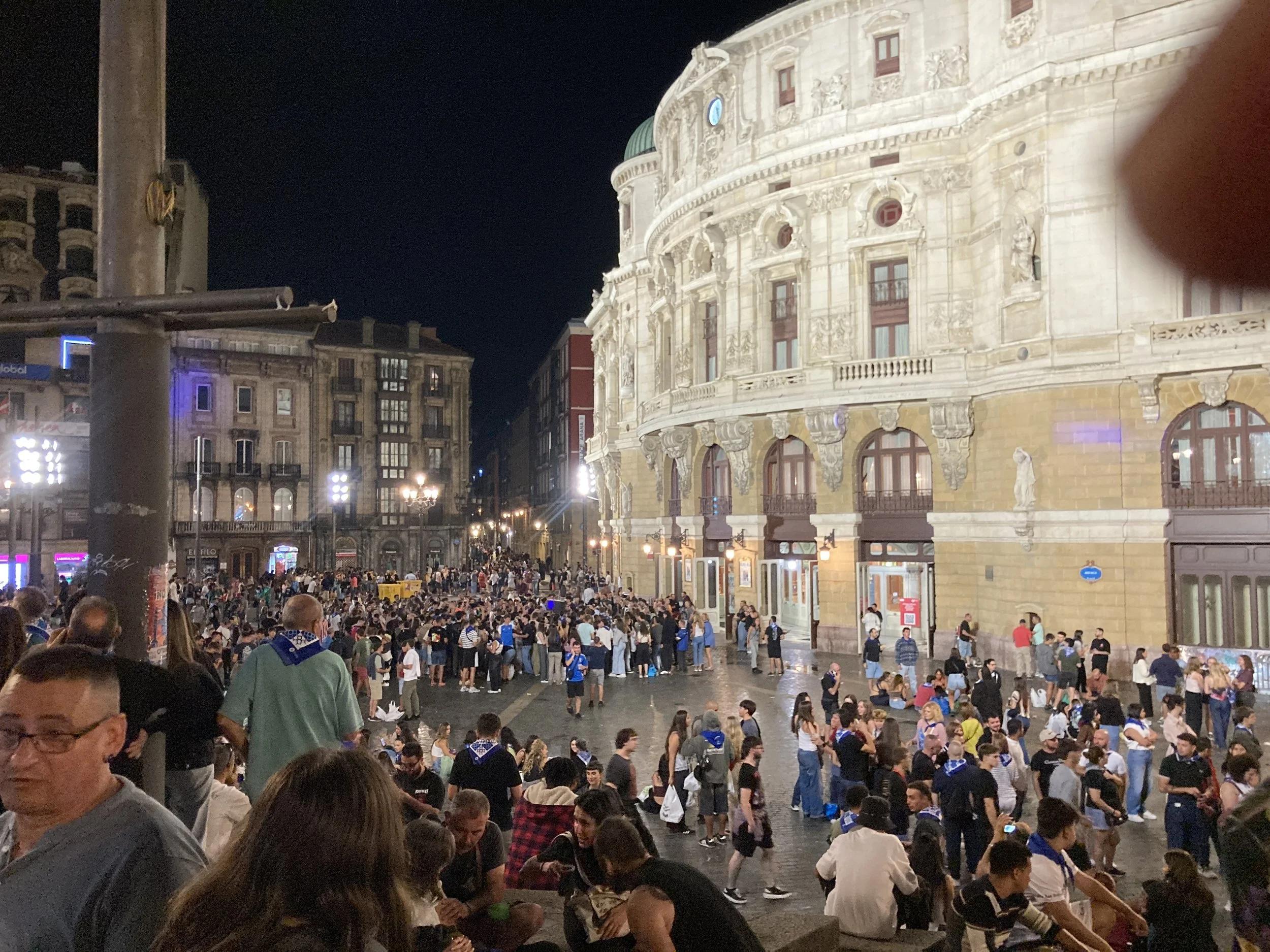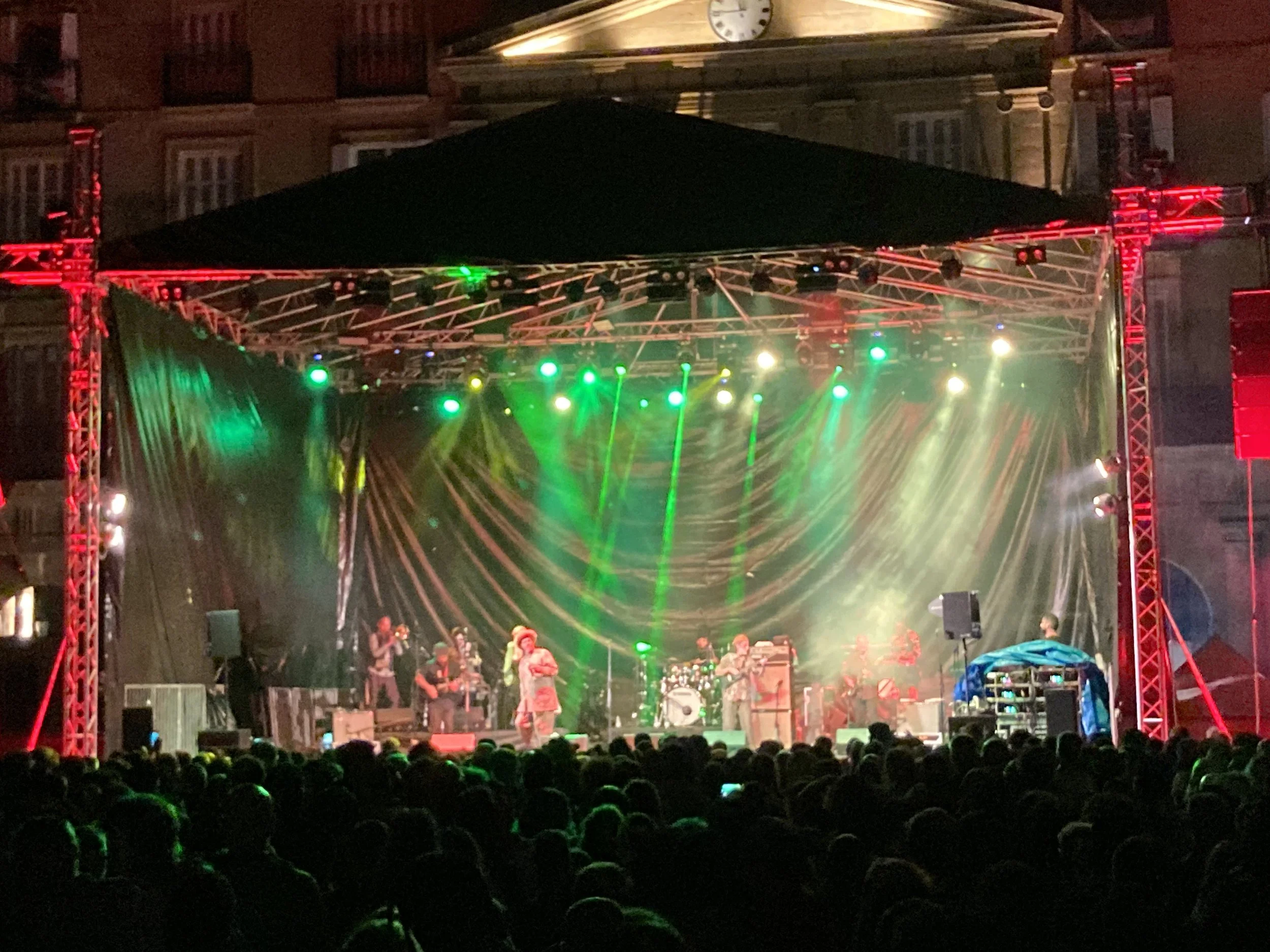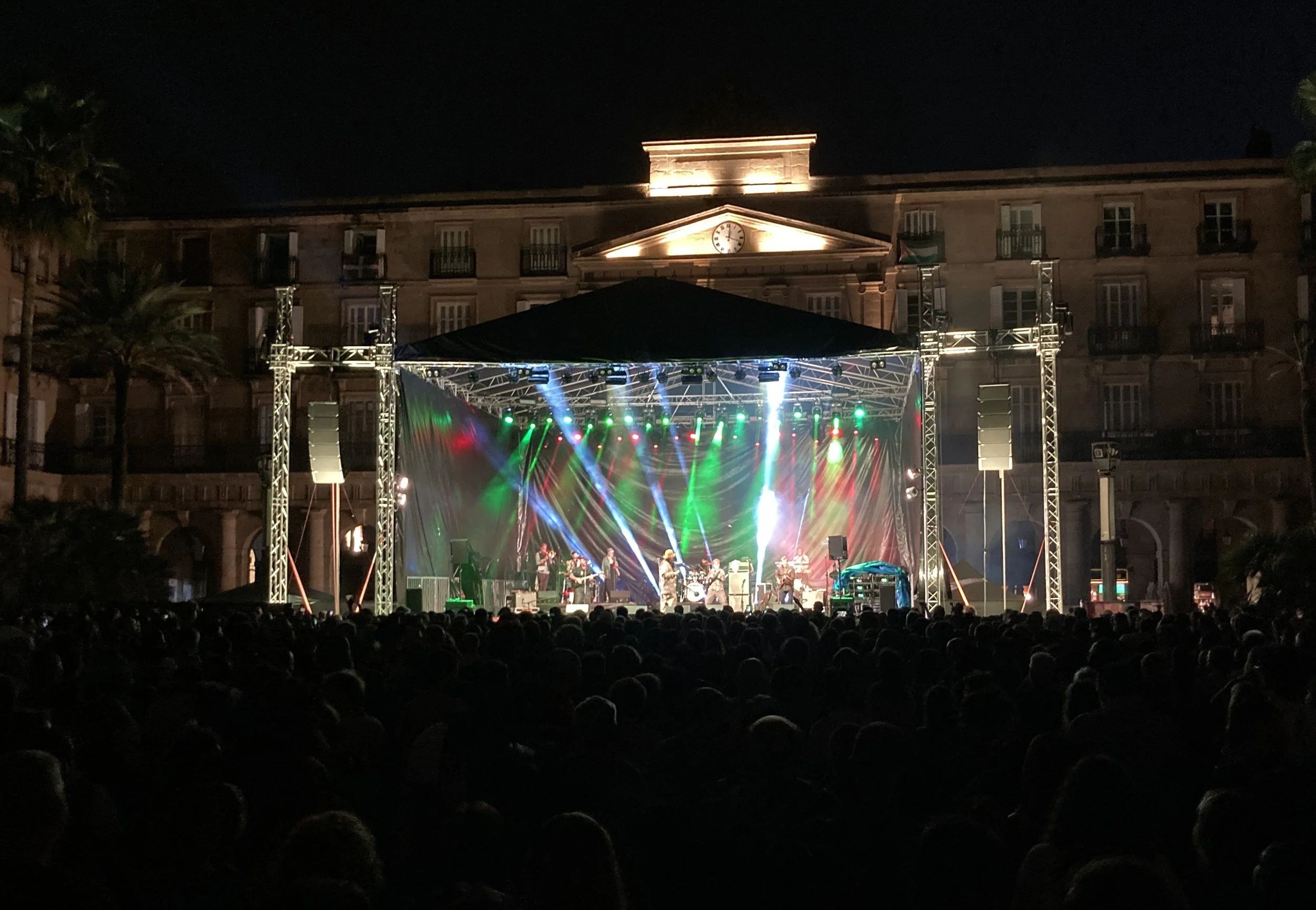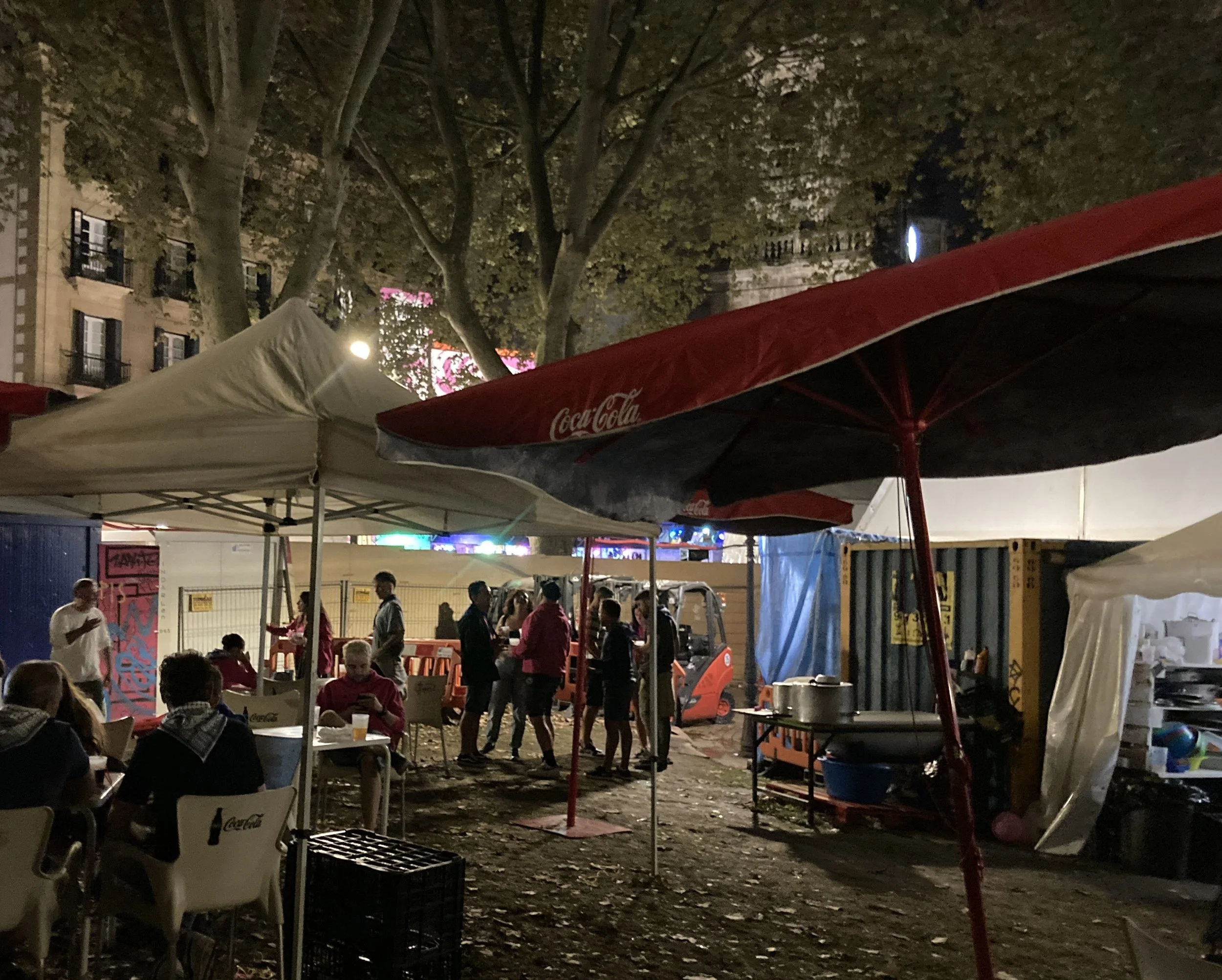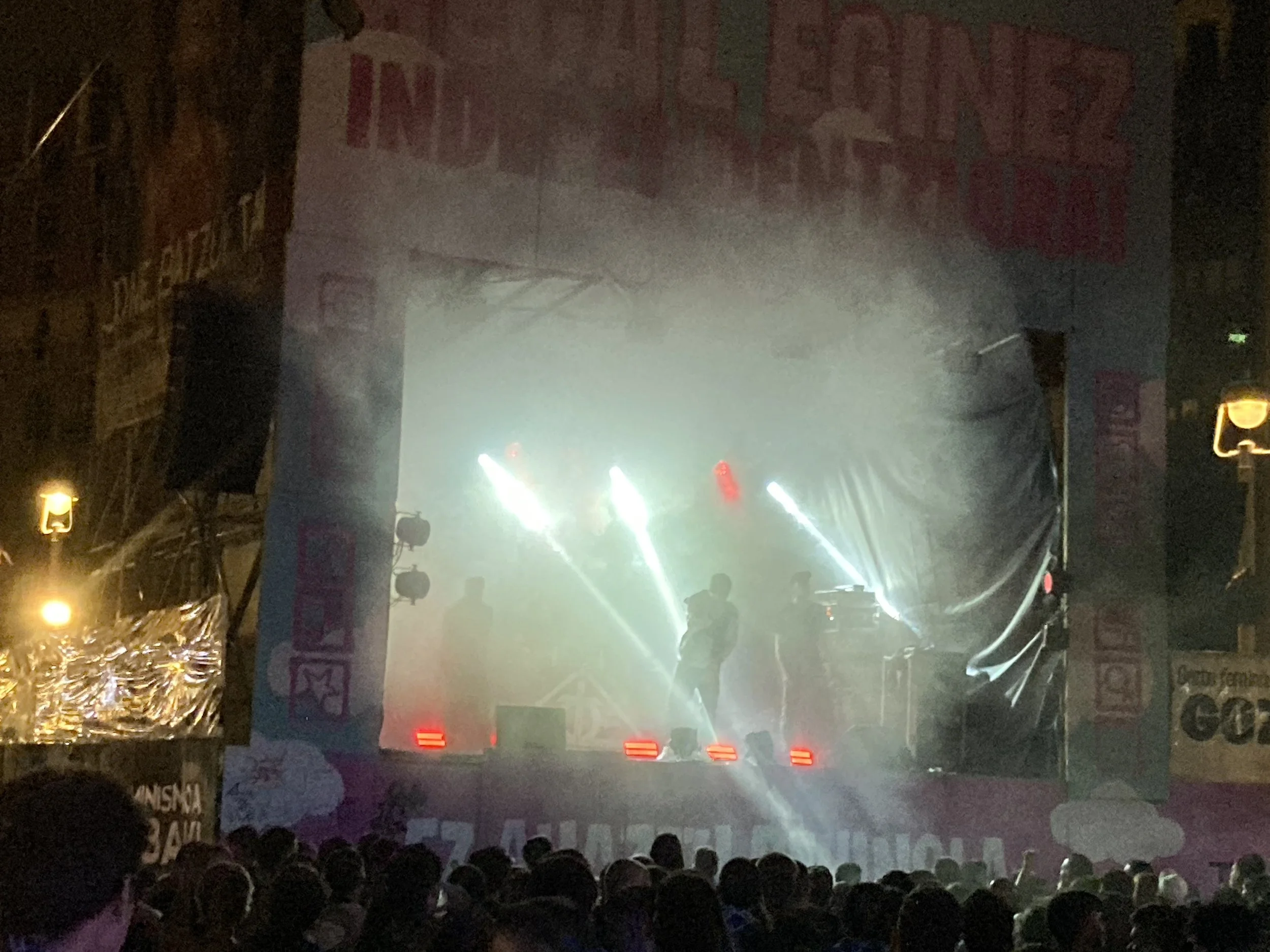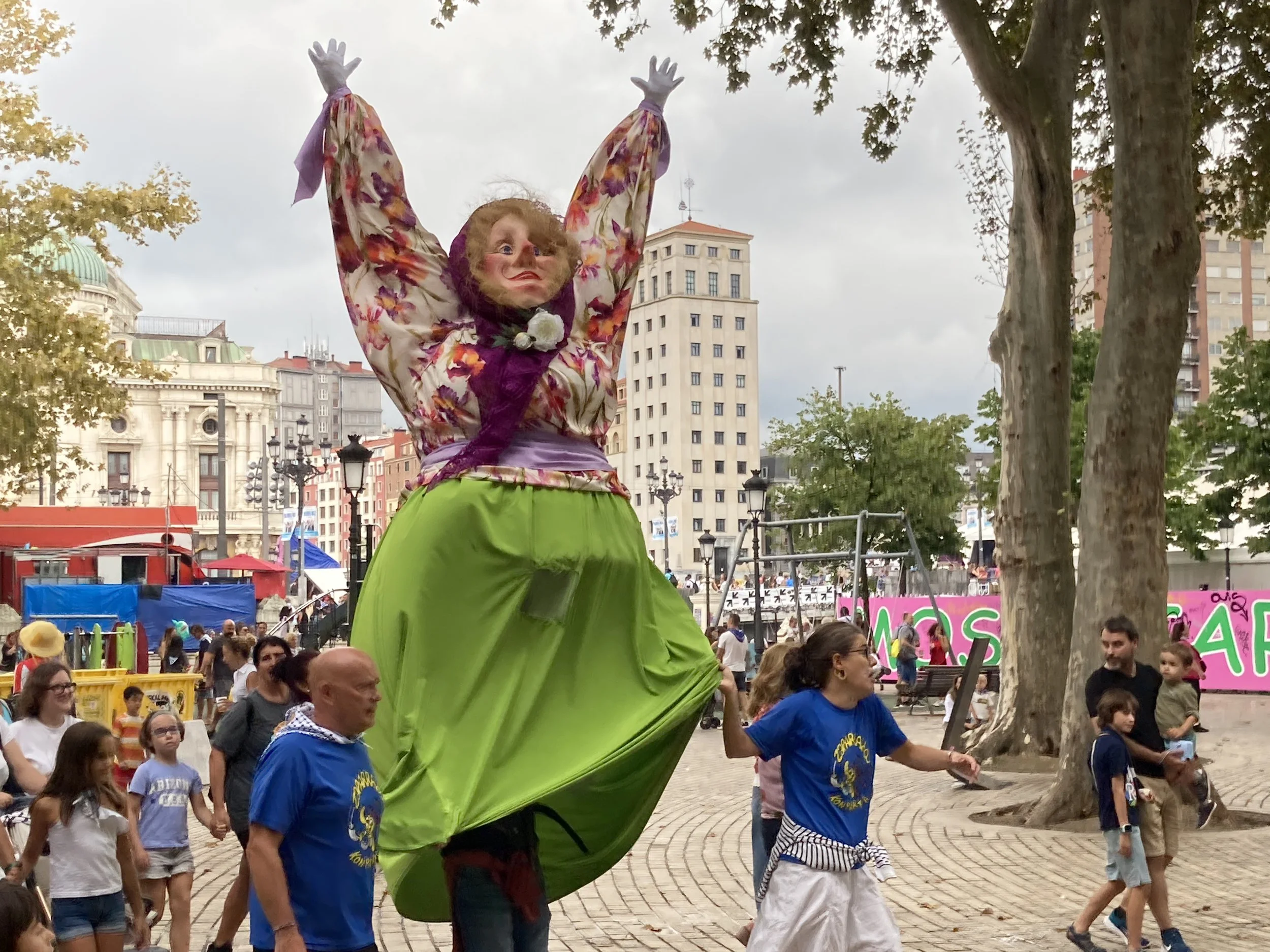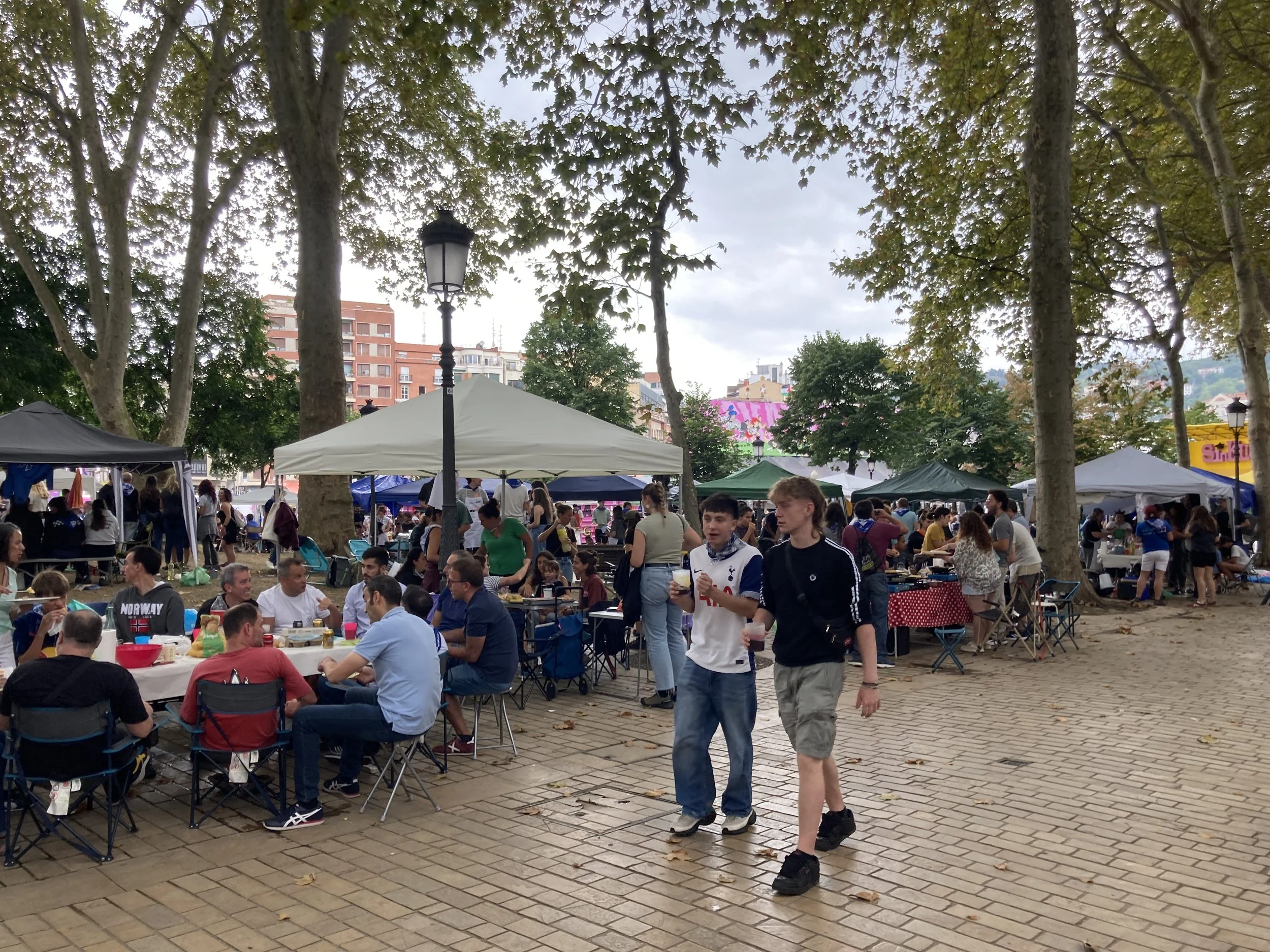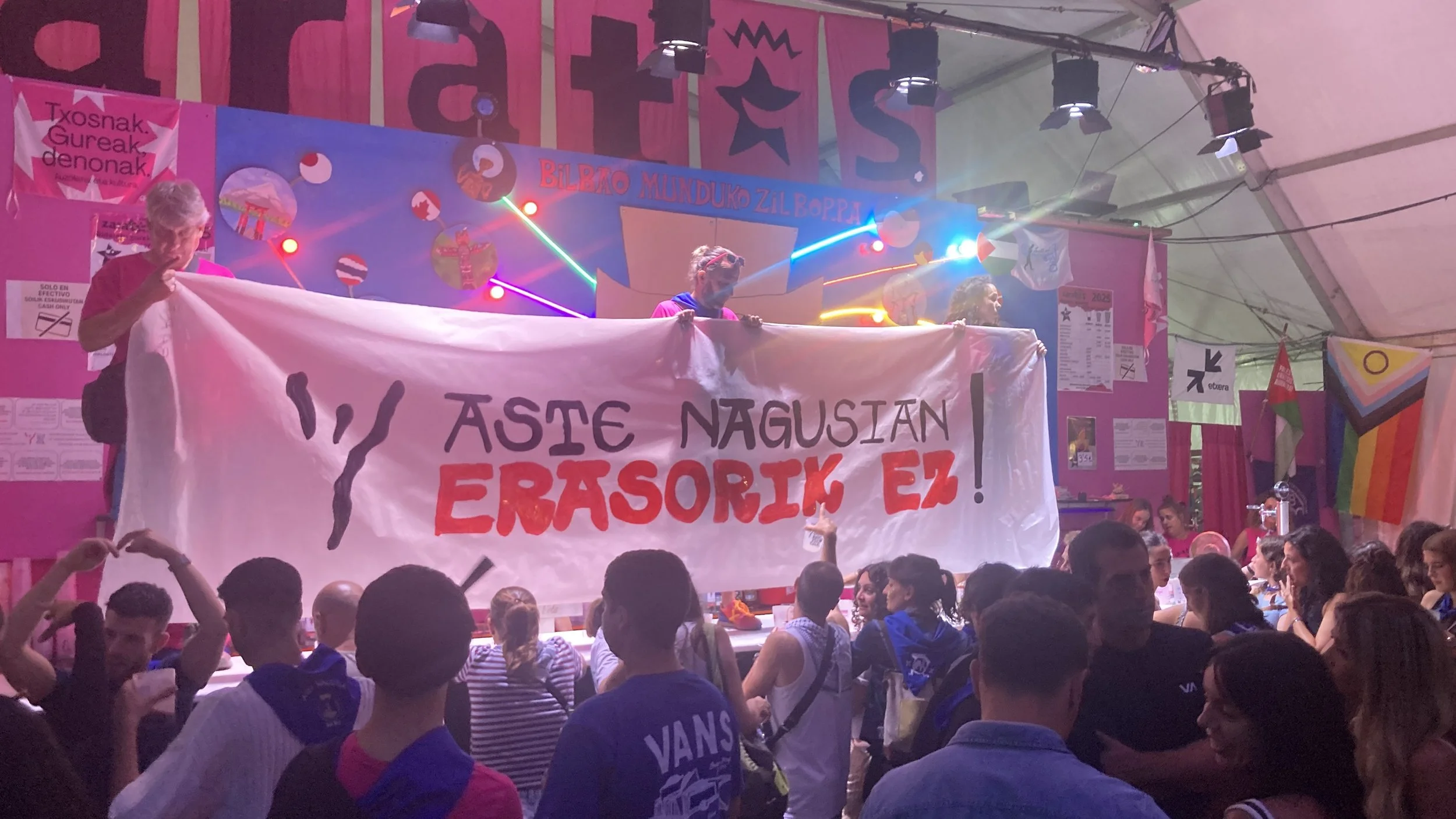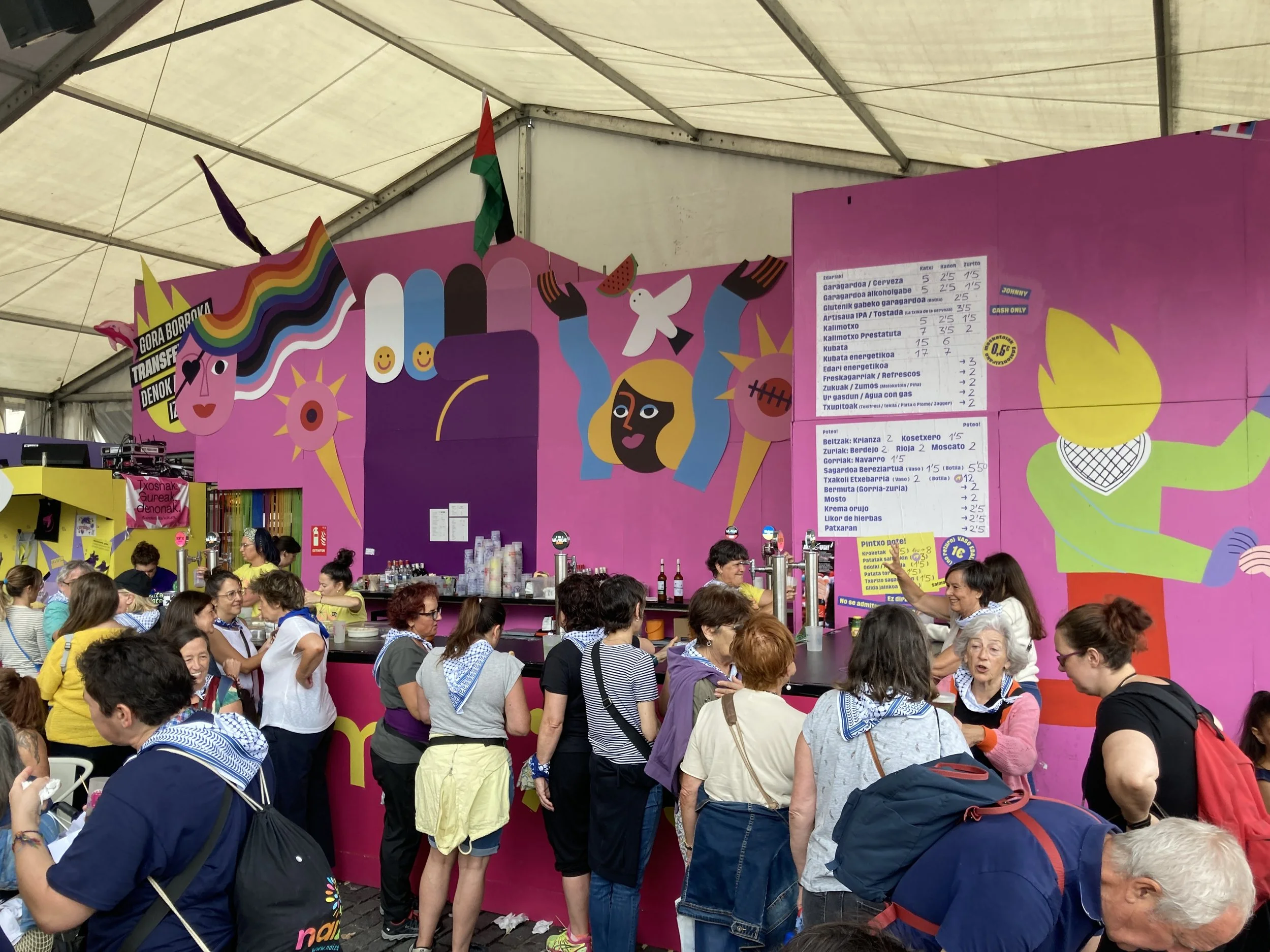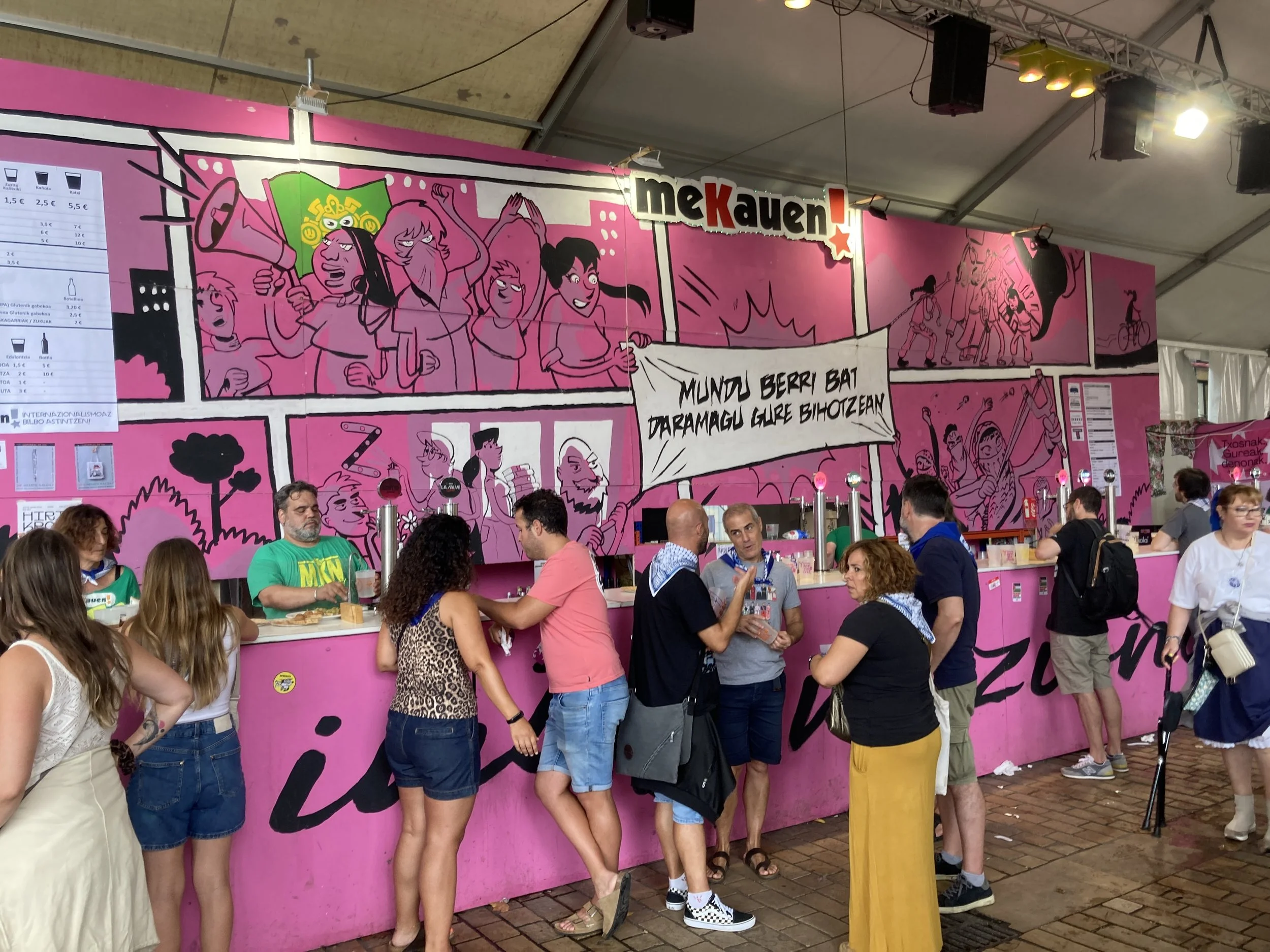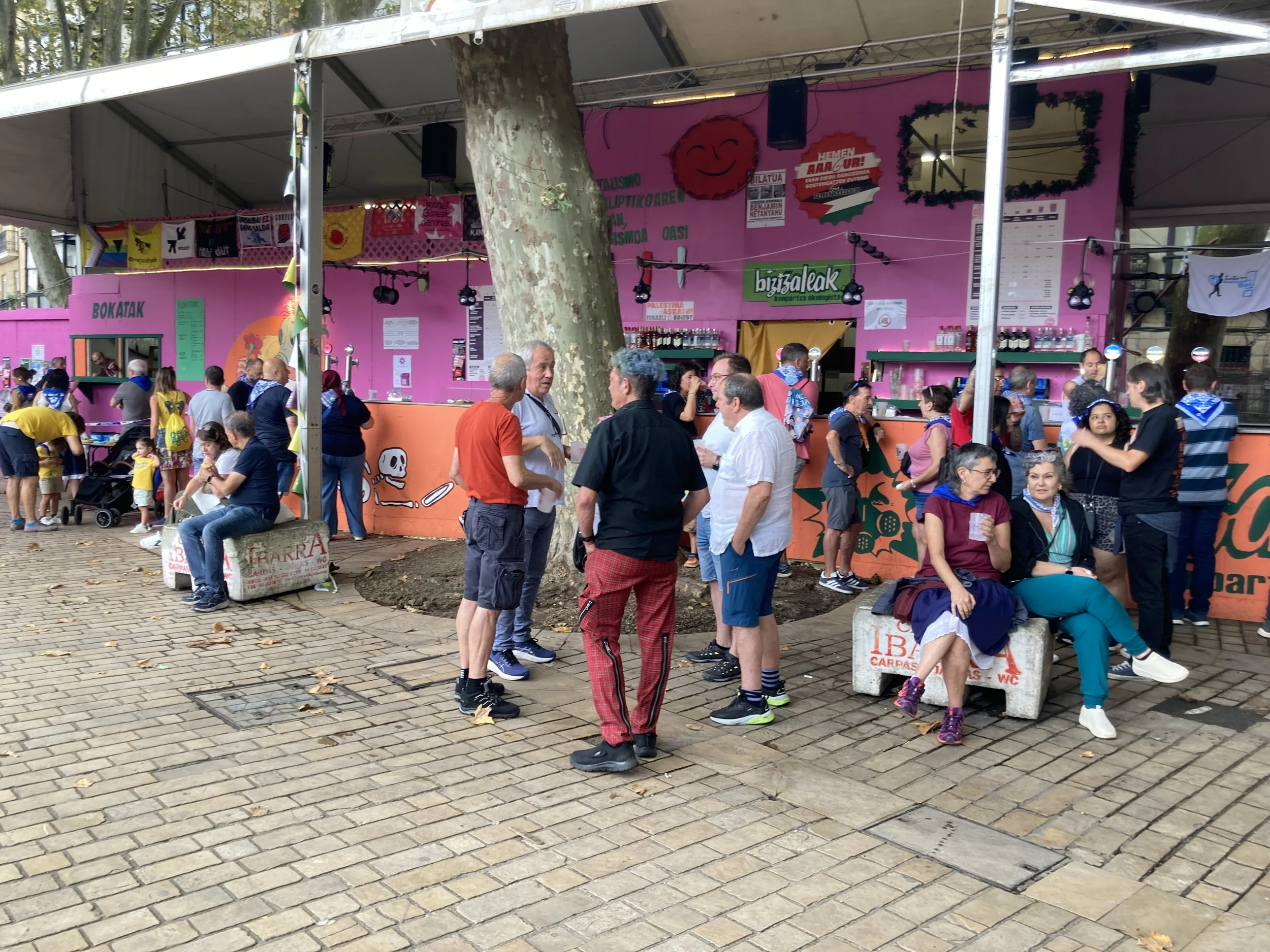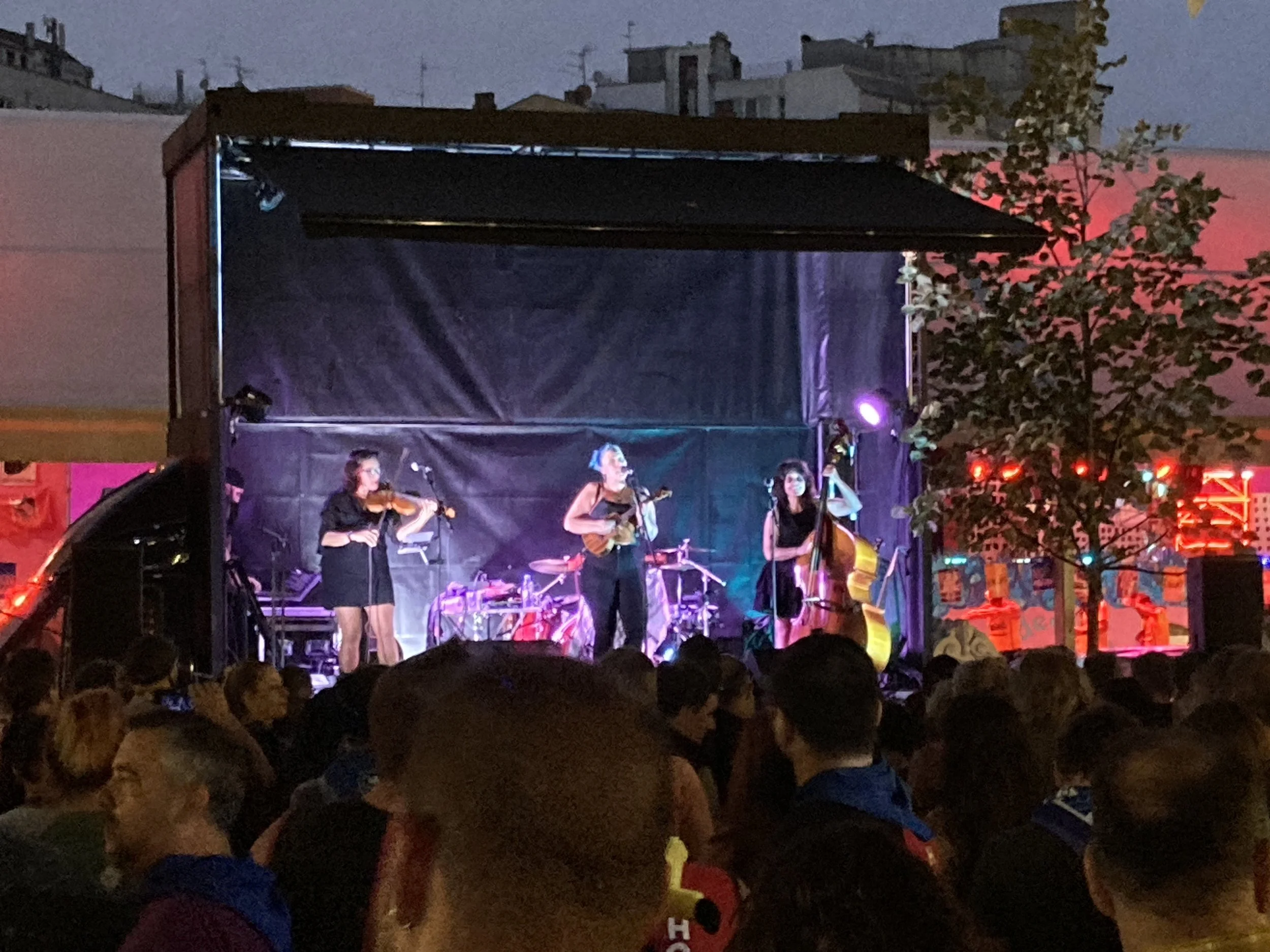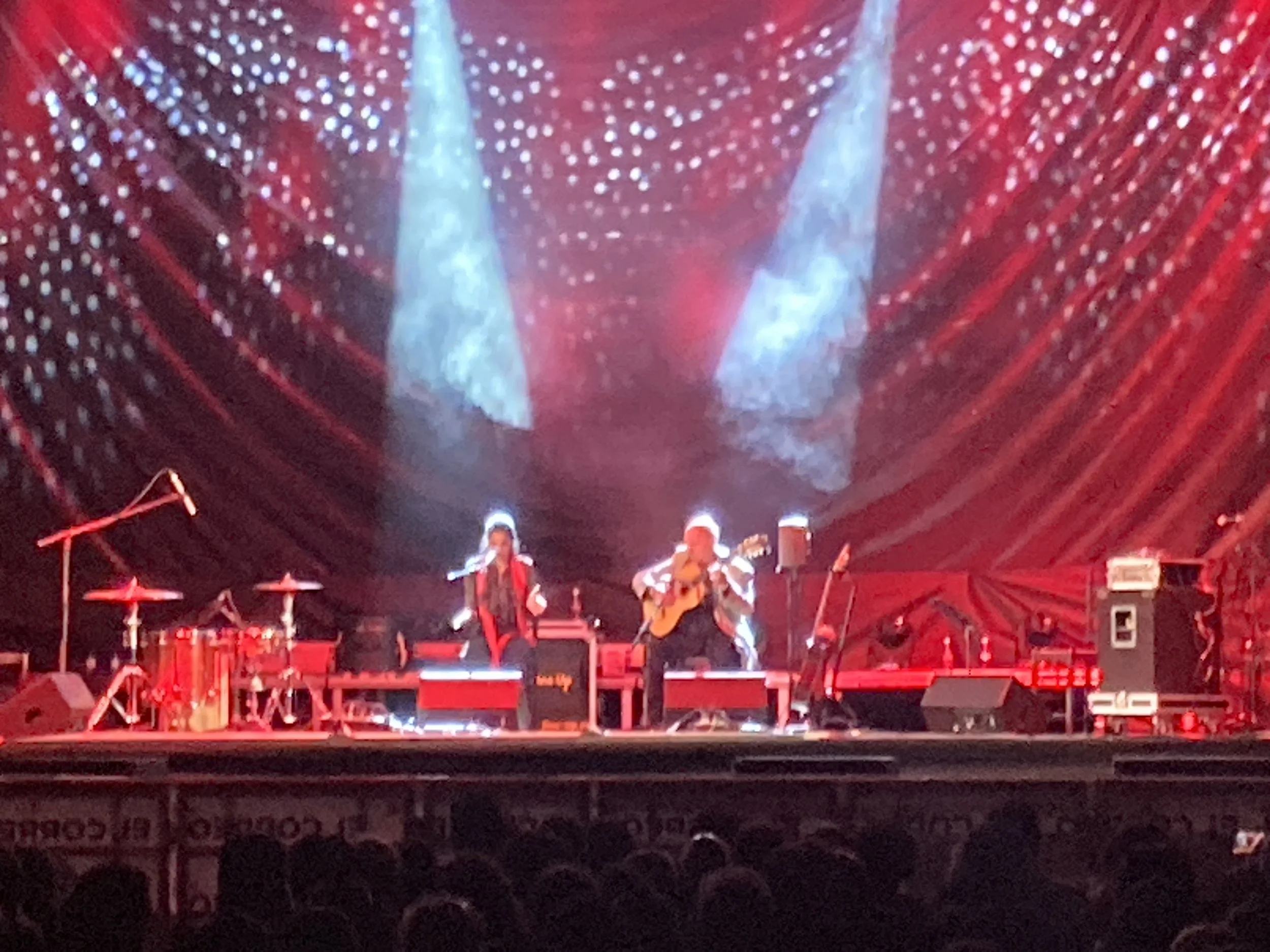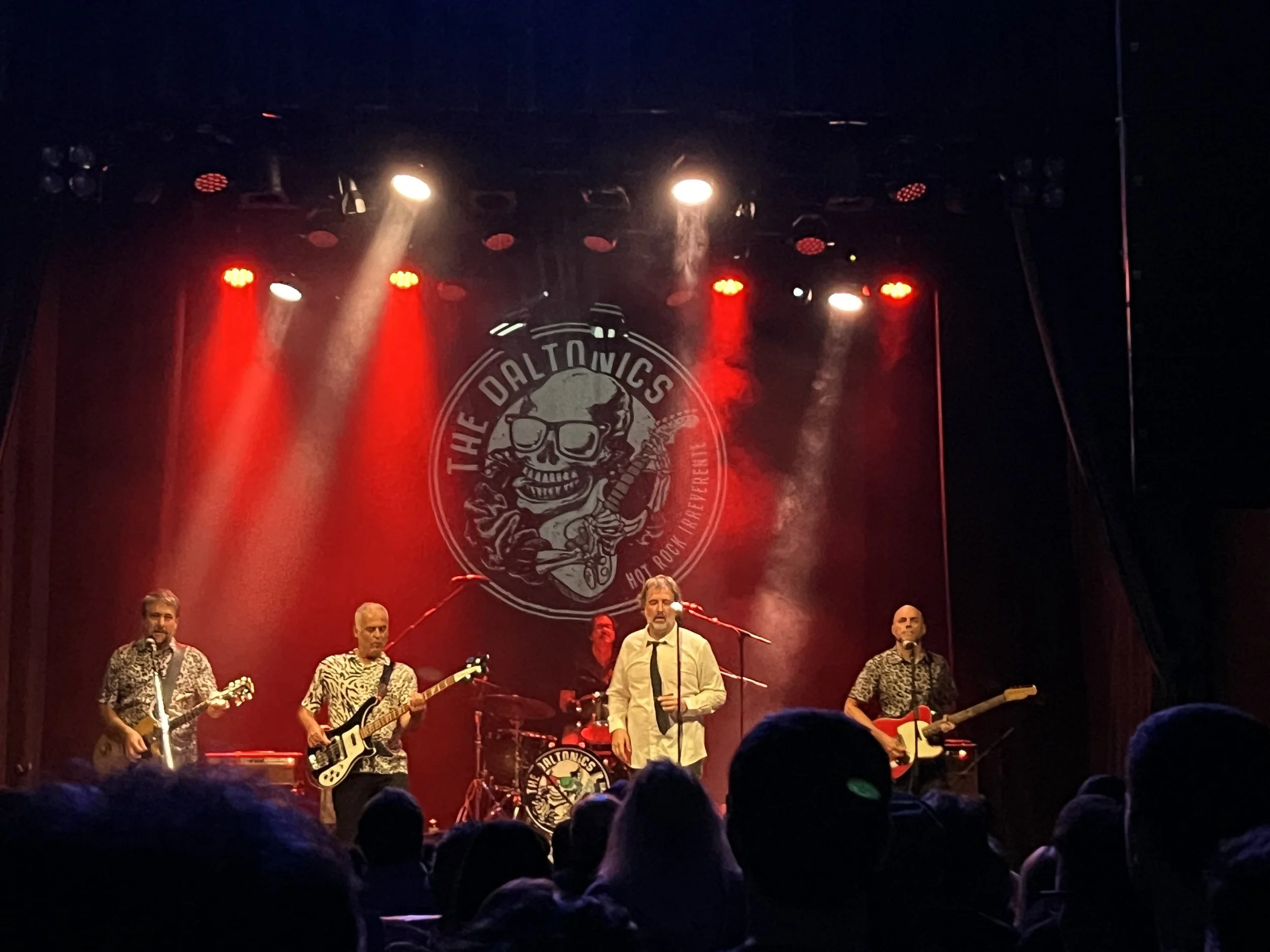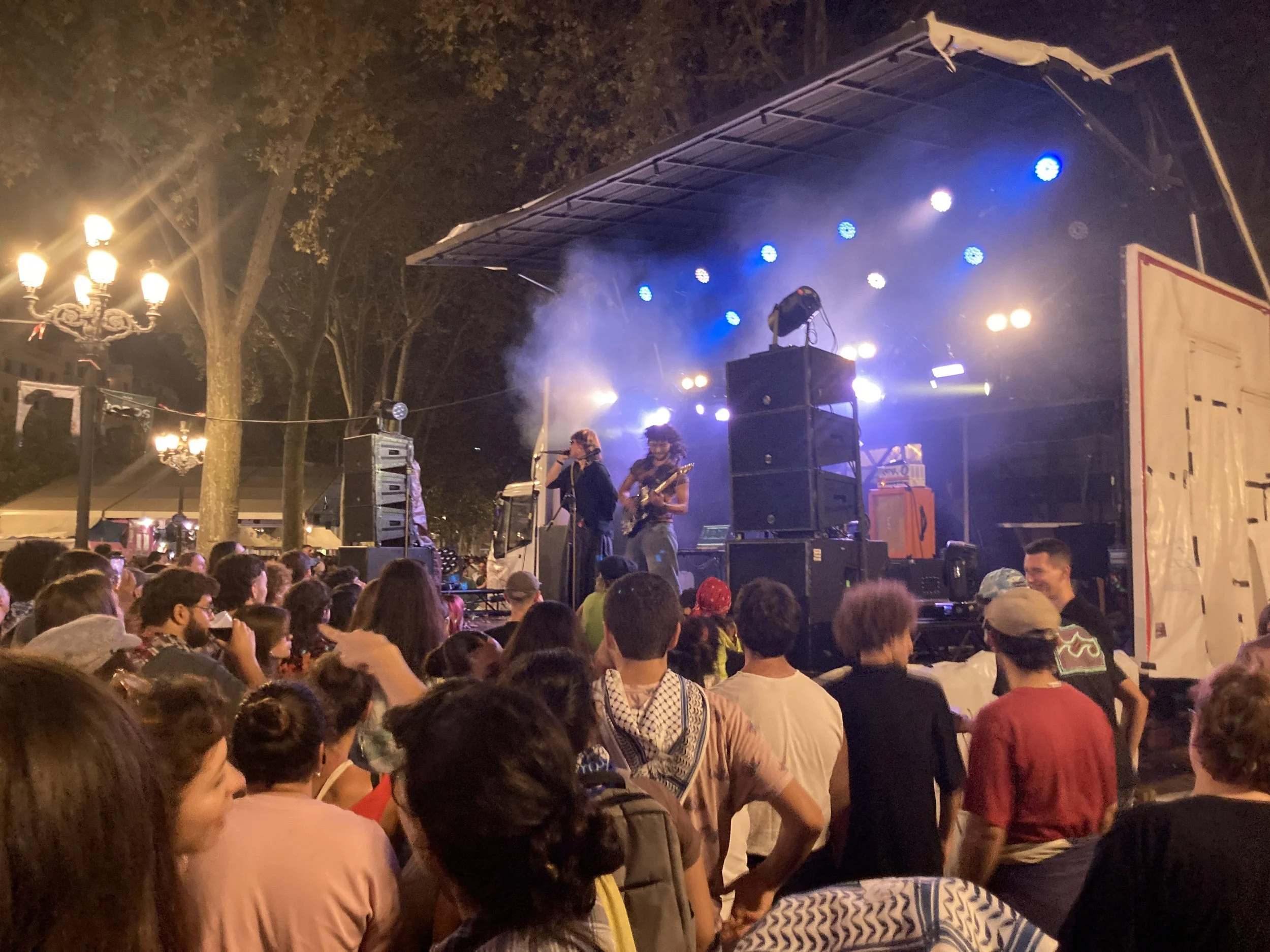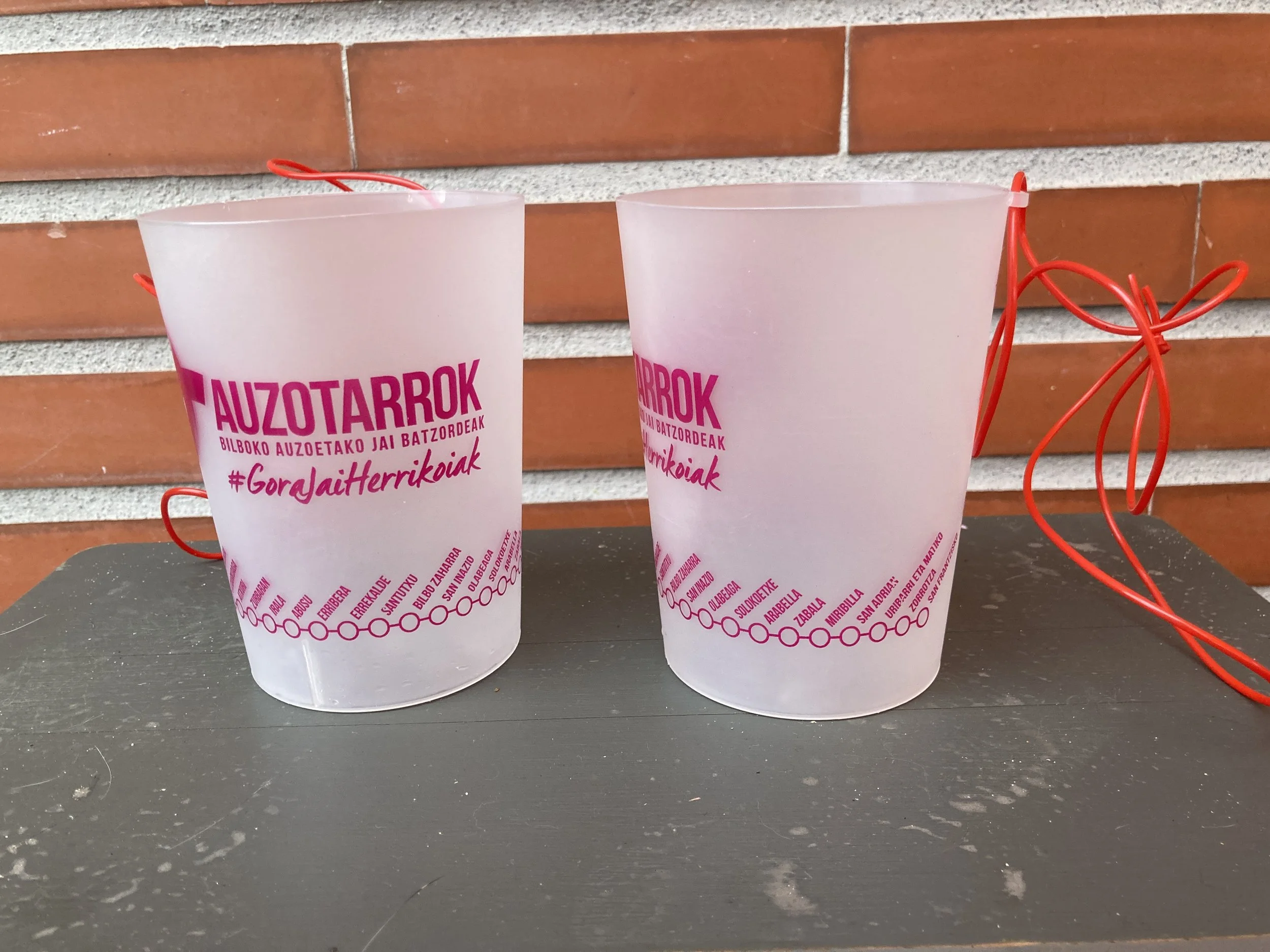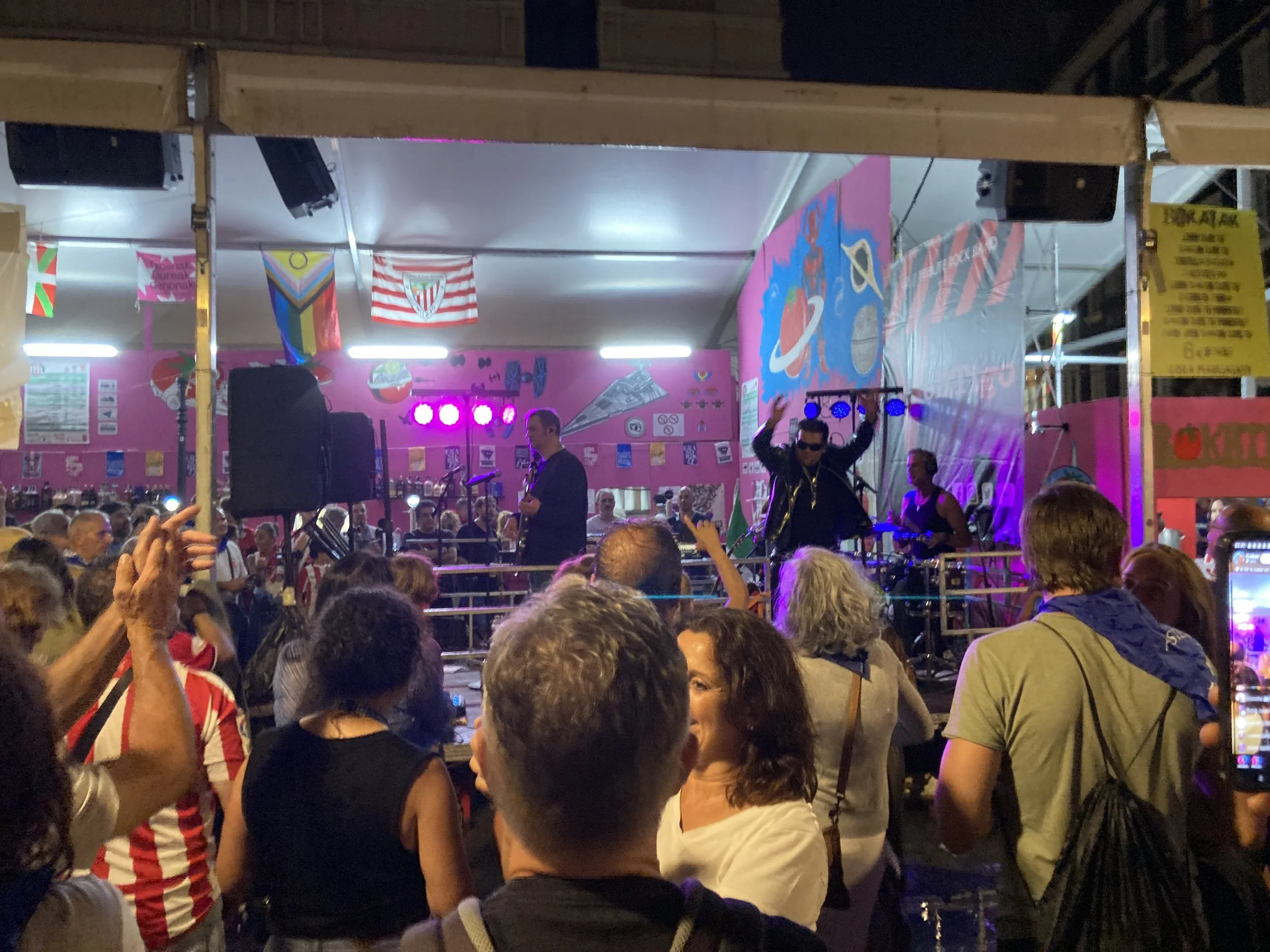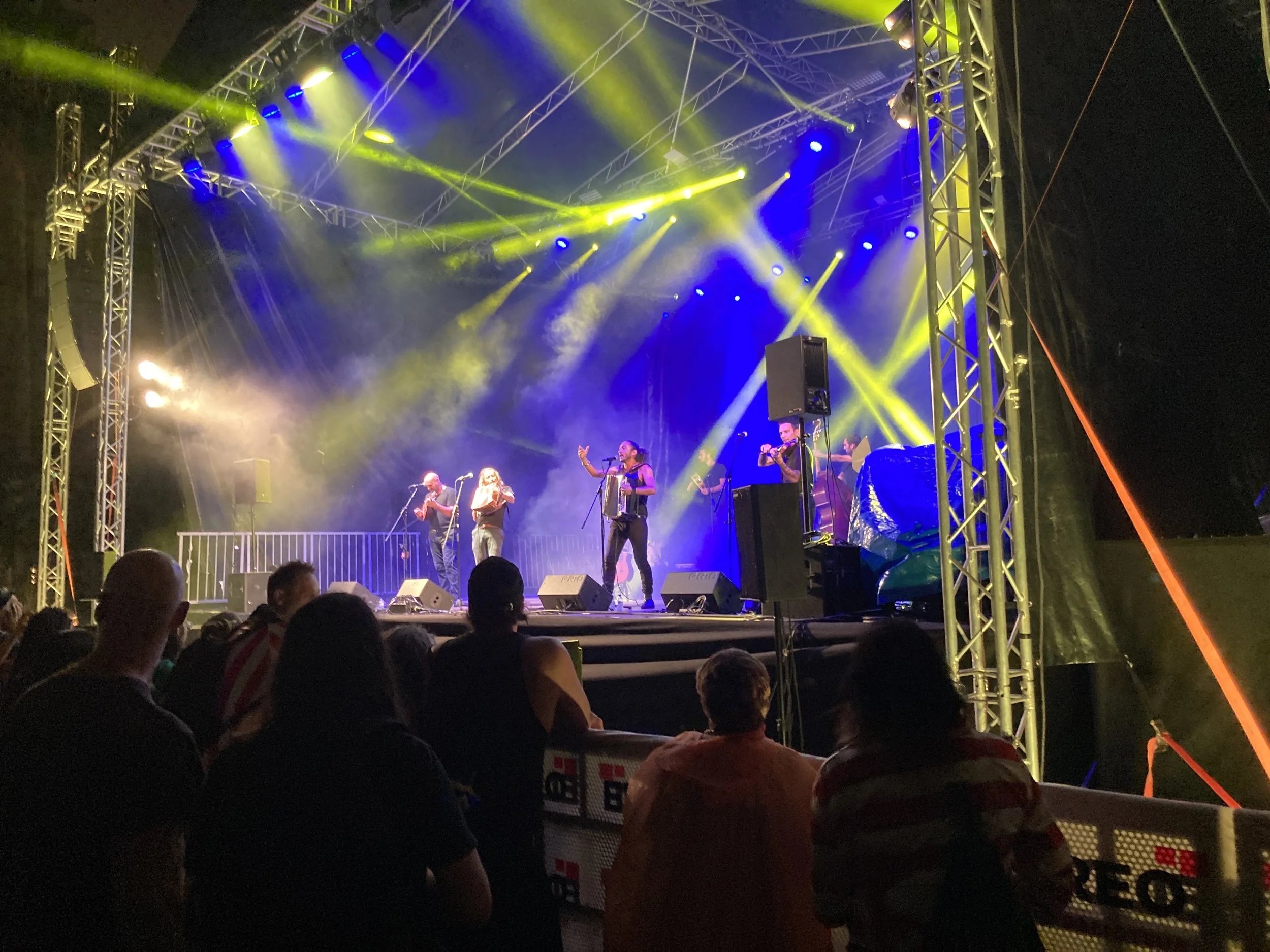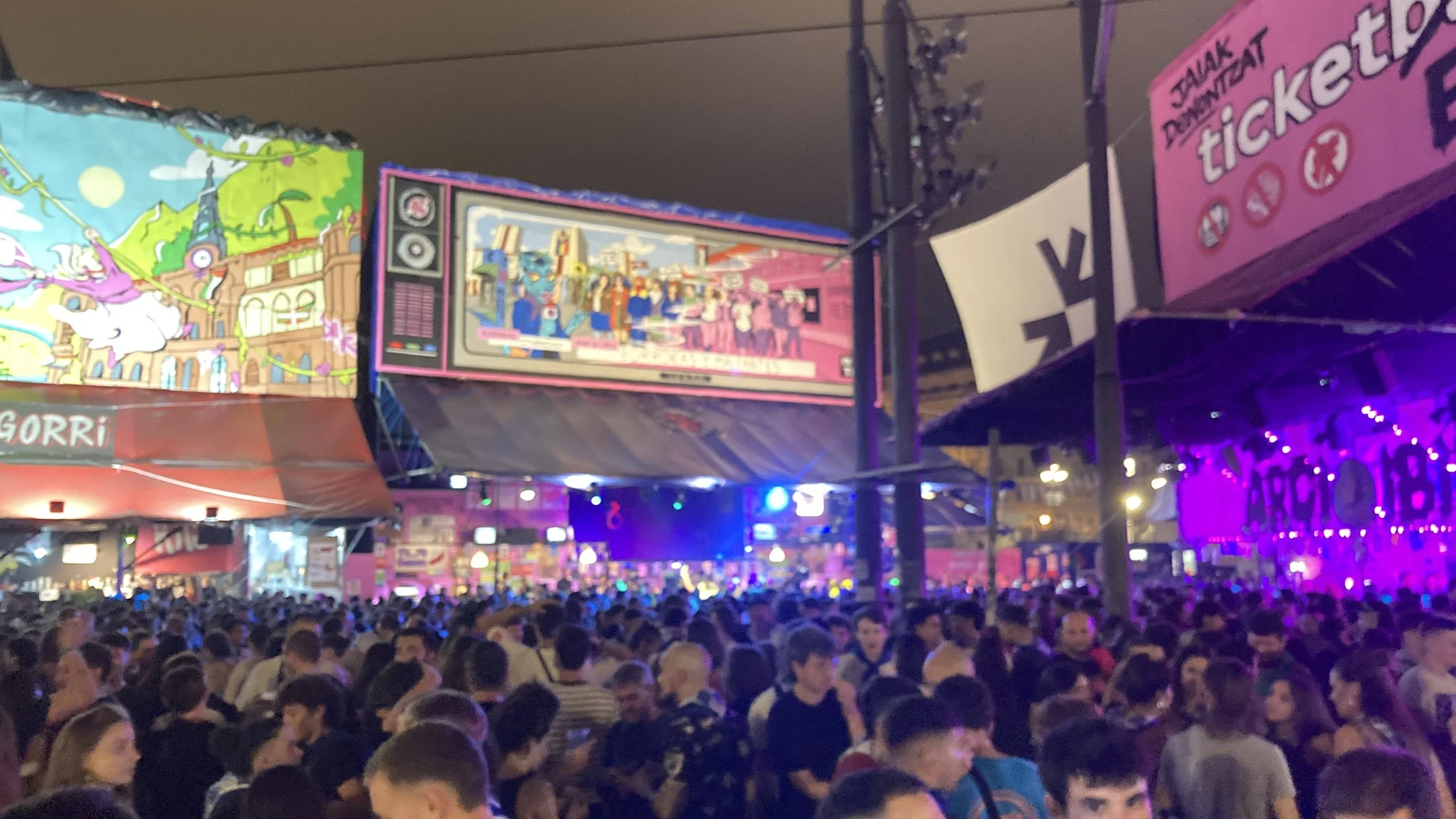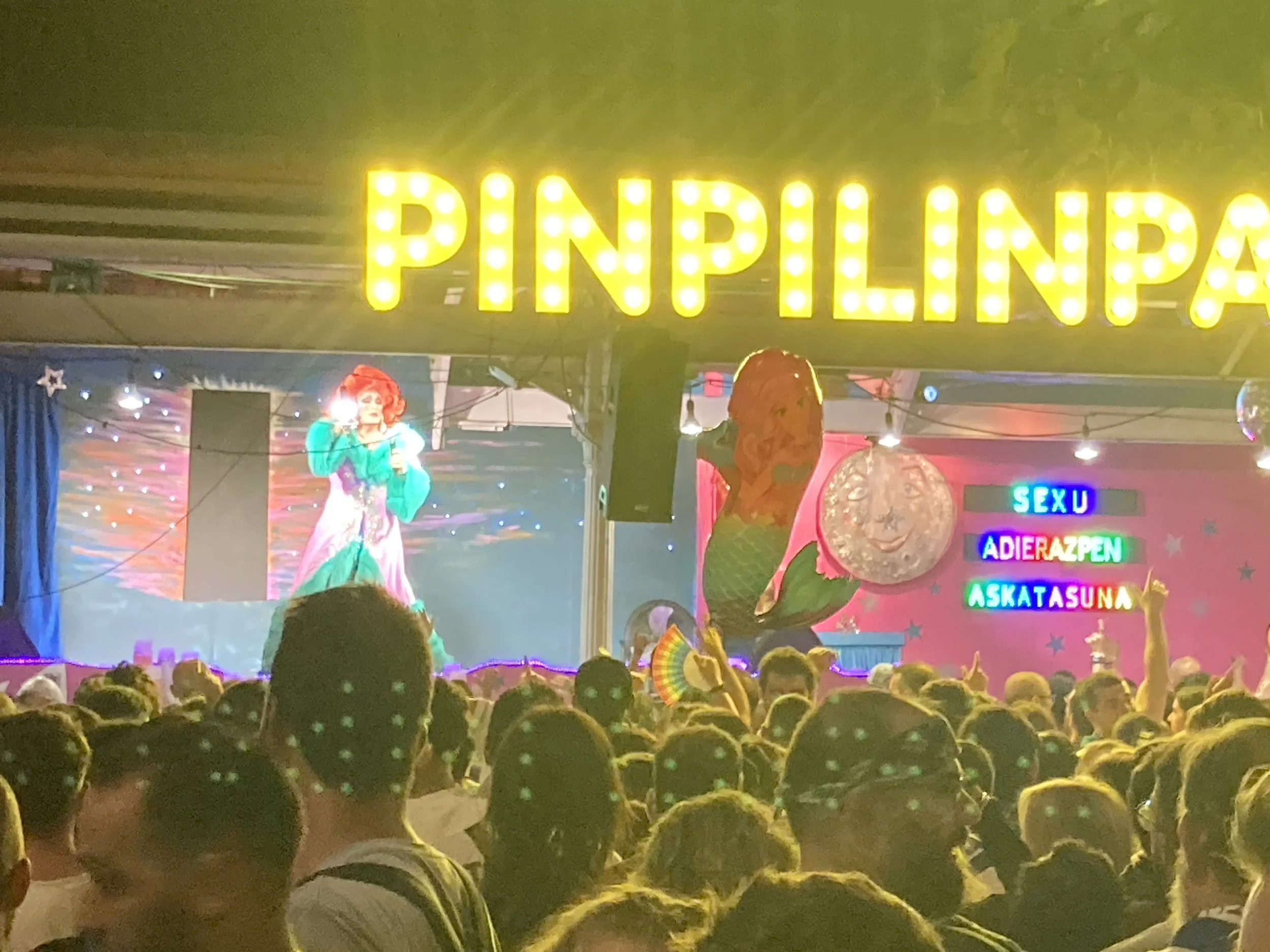Bilbao Big Week Diary
The Marijaia opens the festival (last year)
Day Seven (22 August 2025)
The Aste Nagusia isn’t quite over yet, but I’m afraid it’s over for us. That means we won’t be there for the final, and from what I’ve heard, wildest, night of the festival and that we won’t get to see the ceremonial burning of the Marijaia that will officially close Big Week tomorrow afternoon. Instead, as I write this, M and I are on an airplane heading back to Hamburg, where we’ll most likely spend the evening quietly watching a movie, or at least as much of one as we can manage to stay awake for.
To be 100% honest, I’m not tremendously troubled by this. Of course, my completionist side is slightly miffed that I won’t be able to include any details of the final two days in my Diary, but we had seven nights, six of which we spent hitting the party pretty hard, and I feel completely satisfied with that, completely satisfied and utterly exhausted.
A modest Aste Nagusia crowd
I’m only a little bit sad to miss the last night of the fireworks competition. When we made our travel arrangements, we were under the impression that the last night would be a exhibition performance, probably really cool, but not directly connected to the competition. Unfortunately, it seems that we were mistaken about that, so now we’ll be stuck with one mystery performance that we won’t know how to rank with the others. I’m sure I’ll manage to work though this with time, though.
The good thing is that we managed to take very good advantage of our last night, despite the fact that we had a relatively early flight to think about and couldn’t stay out super late. Of course, a lot of our day was taken up with cleaning everything up from our little party the night before and getting everything prepared for our departure, so it was nearly time for the fireworks when we started to make our way toward the festivities. To save time we grabbed a few beers from M’s fridge and headed straight for the prime viewing area, where we managed to grab one of the last good places to sit down on the pavement.
This time the show was put on by a crew of Italians, who, as we know from our recent spate of research, have traditionally been the dominant firework makers of Europe. Perhaps we were overly influenced by that knowledge, but we both got distinctively classic vibes from their performance. That’s not to say that they didn’t have any new tricks. They pulled out a lot of the same high tech seeming multiphase fireworks as the other teams, including several of those big explosions followed by lots of little crackly explosions, which I’m particularly partial to. Something about the performance just gave us the impression that they were deploying these things according to a structure that some distant ancestor laid down 150 years ago and the entire family has been guarding with their lives ever since. Again, it’s not impossible that this impression may have been slightly influenced by our imaginations.
Sadly, despite what we assume to be their many centuries of familial experience in the industry, these Italians ran into some technical issues midway through their show. Our guess was that their computer must have crashed, but whatever it may have been, the show just suddenly stopped. For a surprisingly long time, maybe fifteen or twenty minutes, the whole crowd just sat quietly and waited for it to start up again, their eyes fixed on the sky. Then the lights came back up, the txosnas across the river resumed their music, and it seemed that the Italians must have either given up on solving their problem or used up the time that was allotted for them to do it.
The disappointed crowd slowly began to disperse, but as M and I still hadn’t exhausted the supply of beer that we brought from home, we just kept sitting there and chatting. And then, in a flash, the show was back on. Either not knowing or not caring that the powers that be had signaled a surrender, the Italians had managed to get their issues dealt with. They came back with an epic finale to rival anything we had seen all week. I don’t know if it will be enough for them to push past the Brazilians and avoid last place, but it makes me smile to think that they’ll be able to return home with their heads held high and tell Nonno that they overcame adversity and completed their show.
Afterwards, we wandered over to the Plaza Nueva, where all we knew was that there was going to be a reggae concert. Well, actually, to be 100% honest, we had been told about the concert the night before, but we had both forgotten all about it and only remembered when we heard the sound of it wafting down the street. Still, we ultimately made it, and that’s the important thing, surely.
The star of the show turned out to be Winston Reedy, someone who is quite well-known within the world of British reggae, but who I, as a person who knows very little about the British reggae scene, had never heard of. For any of you who are as ignorant as I was, Reedy was a member of The Cimarons, apparently the first legitimate reggae group to be formed in the UK. After going solo in the mid 70s, he became a major figure of “Lovers Rock”, a sub-genre that, according to what I’ve been able to gather, followed the lead of rocksteady pioneers like Alton Ellis by pulling away from the spirituality and politics of roots reggae to focus on lighter topics, particularly romantic love.
Winston Reedy struts across the stage
There was certainly a lot of romantic love in Reedy’s performance, but also quite a bit of spirituality, so I suppose we should take the definition with a grain of salt. At any rate, he was extremely charismatic and extremely interested in making sure that the audience knew about the, admittedly quite impressive, string of hits that he produced during his heyday. His band was also quite good, although I’m not sure he agreed. There were a couple of very strange moments in the show when he abruptly stopped the music and had some quick words with them before resuming. I don’t know quite what was going on, but I assume he must have been reprimanding them for something, which seems quite extreme. You hear stories about James Brown and Prince docking band member’s pay for mistakes on stage, but even they, as far as I know, always kept the song going.
The songs of his own that he played were quite enjoyable in their silky sensuality. Some of the vocal mannerisms he pulled out during them also helped me to wrap my head around the connection between roots reggae and dancehall, something that’s always been confusing for me, but the two songs he played that were most striking to me were both covers.
The first was a song called “A Fool and his Money,” by Delroy Fowlin, A.K.A. Bronco Knowledge, a roots reggae figure from the Kingston neighborhood of Trenchtown who came to England in the late 80s and seems to have become a major influence on many of the younger reggae artists who were living there. I haven’t been able to find a version of the song by Fowlin, or by his band from before he left Jamaica (also called Knowledge), but the song was incredible and perfectly exuded that delicate co-existence of tension and relaxation that reggae, at it’s best, does better than any other music.
The second was a version of “You’ve Made Me So Very Happy,” a song that was first recorded in 1967 by Brenda Holloway, who wrote it along with her sister Patrice Holloway and Frank Wilson, and was then made super famous when Blood, Sweat and Tears covered it a couple years later. I assume that he got the idea for this cover from Alton Ellis, who recorded it in 1970, but Reedy’s take was on another level, borrowing elements from the towering arrangement of Blood, Sweat, and Tears’ version and mixing them seamlessly with Ellis’s more understated rocksteady flourishes.
It was a really fun concert that I’m glad we wandered into, but we had to leave a few minutes before the end, because we had an offer that we couldn’t refuse. A friend of a friend of M’s had invited us to stop by the Txosna where she was working. When we got there she let us into the inner sanctum, the backstage area for the members of the konpartsa (the singular form of Konpartsak) to hang out in when they aren’t needed at the bar. It was a crazy experience, and a perfect way to close out our amazing week, to find ourselves calmly sitting around a picnic table and chatting while all around us the surging crowds were packed so tight that they hardly had room to stand.
The inner sanctum
The only downside was that, due to our position right in the middle of the action, we were exposed to the music of so many different txosnas that it stopped sounding like music at all and just became a fluctuating pulse of noise. Fortunately, it wasn’t all that loud, so conversation was still possible, but it did become a bit grating after a while. That was OK, though, because it was time for us to head home anyway. We had to pass a lot of Txosnas on our way out of the insanity, and there were a few moments when we were tempted to stop and join the party for the proverbial one last beer, but we managed to resist and made it home for a late night snack of leftover spaghetti before we hit the sack.
Well, that will be the end of my Bilbao Big Week Diary, at least for this year. I think it will take me a while to fully process everything that’s happened over the past week, but I can say that it has been completely unlike anything else that I’ve ever experienced, and that I am extremely impressed with the city of Bilbao’s ability to throw a party. If you ever have the chance to be there, I can’t recommend it highly enough.
So long for now!
Peter Lawson - 16-23 August 2025
Day Six (21 August 2025)
Last night we hosted a little party at M’s place to watch the fireworks from her terrace, so most of the day ended up being occupied by either writing my report or getting things ready for the party. A lot of the invitees gave excuses, and for a while it was looking like it was just going to be a few people, but then, just before the show started, nearly everyone who had said that they probably wouldn’t be able to make it ended up realizing that they could come after all. I suspect that word might have gotten around about just how awesome of a place M’s terrace is to watch the fireworks.
The show itself was put on by a French crew, and I have to say that they were honestly pretty incredible, but in a completely different way from the Galician crew from the night before. There was none of the subtlety or experimentation that had aroused our curiosity so much in Wednesday’s show. Instead, this show was all about relentless repetition. They would send up the same type of firework, one after another, gradually getting faster and more intense until you could hardly believe they were still going, and then they would take a breath and do the same thing with a different type. At first, we didn’t really see the point. It seemed fairly fun to watch, but not particularly impressive, but eventually they won us over with their obsessive and singular dedication to this principle, and by the end I think everyone on the terrace was pretty much awestruck.
The actual fireworks they used for this were for the most part quite conventional and unextraordinary, but they had one special effect in their pocket, and it was something marvelous. They would put up more or less ordinary looking fireworks of the classic big round explosion style, just like all the others that they used, but as the initial blasts faded, they left behind a field of tiny white points of light that seemed to stay in one spot. Over time, more and more explosions left behind more and more points of light until the sky seemed to be filled with them. It was truly beautiful.
After the show we went down to join the festivities, but we had a logistical issue to deal with and then we ended up mostly just hanging out and talking a lot, so even though we were out later than we had been any other night, I don’t really have that much to report on. We were hanging out in the final cluster of txosnas as you walk down the river, an area known for being the home of some of the most radically leftist konpartsak, and because today is a holiday it was quite crowded, but fortunately it had rained a bit in the early evening, so it wasn’t quite to the level of Day One.
There was a concert of Odei Barroso, a well-known Basque rapper and bertsolari (traditional Basque improvisational singer/poet) happening on the stage of the Kaskagorri txosna (according to them, the meeting place for Bilbao’s rebellious youth). This performance definitely seemed to be more in the hip hop direction, and my impression was that he, and the other people he had on stage with him, were quite good. It was mostly quick, intricate sounding stuff with frequent surprisingly angular rhythms and, seemingly, a good deal of electronic dance music influence. Unfortunately, from where we were standing, the sound was pretty well swallowed up by the noise of the party, so it was difficult to get that clear a picture of what was going on except for the few times when I left the group and headed over for a closer look.
Odei Barroso on a smoke-filled stage
Other than that, there’s not really anything else to report, except that I finally had the chance to try the churros that I’d been eyeing since Saturday, and they were delicious. Tonight will be our last night at Big Week, so check back in tomorrow to see if we end up running into any surprises!
Day Five (20 August 2025)
Around the middle of the day we got a message from some friends that they were hanging out at the feminist txosna, and we should come meet them there. This was somewhat unhelpful information, as there are several txosnas that more or less fit that description, so it ended up taking us quite a while to pin down their location. While we were on the hunt, I noticed a small parade of people carrying the Marijaia down the street, so I figured I would position myself in front of her to try to get a good photo. Well, she wasn’t having it. Everywhere I went, she took a turn and headed the other way. After this happened four or five times, I was starting to think it was a lost cause, but then they stopped in front of the gazebo in the paseo del Arenal to make some adjustments, and I was finally able to get the shot.
While I was busy with that, M had finally figured out where our friends were, so we headed over to join them and have a beer. It was a nice chill scene at the txosna, completely different from the crazy chaos of the night. There were quite a few people around, but it wasn’t packed, and there were even a few tables and chairs set up where people were sitting around and chatting while they sipped their aperitivos and munched on pintxos (basically the Basque version of tapas, usually consisting of a little piece of bread with something delicious on top of it).
As we were getting settled in and M got involved in a rapid-fire Spanish conversation that was beyond my ability to follow, I noticed a street performer getting his stuff set up in the square nearby, so I wandered over to see what he was up to. I was particularly intrigued, because I noticed that he had a brightly colored bullwhip, which I thought might be an interesting thing to show my son. Recently I was trying to tell him about the year when, as a child of the 80s who was born the same year as Indiana Jones, a bullwhip was the one thing in the world that I wanted more than anything else; I even remember having dreams about bullwhips. Well, as it turns out, a bull whip is a relatively difficult thing to describe to someone who’s never seen one, so this seemed like a good opportunity.
Anyway, I wandered over to the area where he was performing and started to watch him do his thing. He was a quite young guy from Seville, which M tells me has a reputation for producing the funniest people in Spain, and he definitely lived up to that reputation. He pulled a kid of around ten out of the audience (a real sport; I wondered if he might be a plant, but I don’t think so), and the two of them started to demonstrate feats of strength — push-ups, cartwheels, lots of flexing, etc. — for the audience. At one point the performer did a back flip and then had to run over to stop the kid from attempting one himself, after which he picked the kid up and flipped him over by hand as a way of maintaining parity without the risk of tragic consequences.
Pretty early on in the show he noticed me standing off to the side and taking some photos, so he came over to say hi and do a bit of posing for me.
It was probably inevitable at that point that I would be pulled into the show too. I ended up holding the bullwhip up in the air, along with another audience member, for the sevillano to do a back flip over it, which was really quite astounding. Then, as the grand finally, he had me and four other audience members crouch down so that he could do a flip over all of us. Afterwards he put out his hat and said that the first person to give him five Euros could touch his abs (which were impressive). One of our friends turned out to be the first (M and the others had come over to watch when they saw that I had become a part of the show), but she turned down the offer, saying that he was too young for her.
Actually this is a story that took place on Day Four, but I’m telling it now because I didn’t have space for it yesterday, and because M and I decided to take a day off from the heavy partying and just hung out while I did my writing and M did her stuff. I ended up finishing getting my report for Days Three and Four posted just in time to see the fireworks, which was our only direct experience of Big Week Day Five.
But what fireworks they were! It was a group from Galicia, the region of Spain that sticks out over Portugal to the Atlantic, and from the start it was clear that their approach was vibrant and full of color. As the show went on, though, I felt more and more like I was seeing something new. Typically, when you think about a professional fireworks show, intensity is the main mode of expression available. The Germans from the other night, for example, were mainly impressive for their ability to sustain an impressive level of intensity over a long period of time (Germans are pretty good at intensity). These people could definitely provide intensity too, but there were also parts of the show when they made these showers of color that were incredibly beautiful and really quite relaxing, and there were other times when created waves of tiny explosions like popcorn popping on fast forward. I’m not quite sure how to describe the experience of it, but it was definitely something different.
Maybe my favorite thing was these fireworks that sent out a burst of colored lights, each of which then proceeded to explode into either three or four new lights, creating what looked like a kind of complex mathematical flow chart. M said that she had seen the same kind of thing at Big Week last year, but it was something completely new to me, and I was astonished. This was a fireworks show that was as interesting as it was exciting.
Of course, they brought it with the finale as well, and the roar of cheers that rose up from the city when they were done made it clear that I wasn’t the only one who felt this way. M wasn’t quite as convinced as I was. To me this team was the clear leader so far, but she wasn’t sure if she would put them or the Germans at number one. I think she was also pretty intrigued by the show, though, because the two of us ended up talking about fireworks, how they might be constructed and what all the variables that might effect a performance might be, for several hours after the show ended.
We’ll be back to the party tonight, so keep checking in to see what we end up getting into.
Days Three and Four (18-19 August 2025)
Well, here’s what happened. Yesterday around midday I was gearing up to write my report, when we got a message that a few friends from out of town were chilling down at one of the txosnas and we should come join them, so we figured it couldn’t hurt to head down and hang out with them for a little bit, and then I could write the report later. The next thing we knew we were engaged in some serious day drinking, which eventually turned into night drinking, and then suddenly it was three in the morning. As a result of those unforeseen and essentially unavoidable circumstances, I’ll be providing you with a double entry today.
To start with, there’s a major aspect of Big Week that I haven’t really gotten into yet, and that is politics. There is, first of all, something profoundly political about the structure of the event itself. At least down in the Casco, literally everything is organized on a grassroots level, by and for friends and neighbors. It would be hard to imagine a big event like this being less corporate, which is an extremely refreshing thing to see. This comes across even more clearly in the middle of the day, when hundreds of families and groups of friends set up tables next to the river in the paseo del Arenal and prepare food for each other — mostly tortillas from what I was able to see — on little portable burners. Day and night, though, the event is a powerful example of what ordinary people can accomplish when they come together and cooperate with each other, and this seems to have a striking effect on the vibe. Although I’ve seen a few people engaging in truly shocking behaviour, I still haven’t seen a single fight break out. That’s of course not to say that none have happened, but it’s still fairly surprising.
There’s also a lot of more overt political stuff going on. All of the konpartsak (participating community organizations) share, first of all, a deep investment in the culture and language of the Basque Country. Basque identity, whether expressed in terms of cultural advocacy or overt political nationalism, is the universal principle that unites essentially all aspects of this event. Many of the konpartsak, as you might expect, are also sponsored by protest organizations that advocate for various issues, including antimilitarism, LGBTQi rights, feminism, animal rights, and antiracism, among others. Even those that aren’t, though, nearly all incorporate political messages of some kind into the decoration of their txosnas, usually presented with a healthy dose of humor, and it would be quite unusual to see a txosna that doesn’t feature some kind of show of support for the people of Palestine.
There are also relatively frequent breaks from the festivities when the music is turned off and people stand on stages or right on the bar to give speeches or read brief statements. You might imagine that all these factors might make big week unwelcoming to outsiders or alienating to anyone outside of an intensely political in-group, but everything seems to be done with such a focus on acceptance and inclusivity that neither of these things seem to be the case at all. In fact, it’s striking just how widely embraced the tradition of big week seems to be in Bilbao. As you walk around through all the madness, you seem to see everyone, from the youngest to the oldest, the most straight-laced to the most countercultural, local natives, immigrants and visitors like me.
Which brings me to our experiences on Tuesday, day three of the festival, when, finally, we managed to make our way down to the Casco and and find out what goes on there during the day. This was just a brief trip down for lunch, but it was made more interesting by several encounters with informal marching bands, often made up of entire families, that roam the streets of the old town. One in particular stood out because they were each playing a drum called a tabor with one hand and a three-hole pipe with the other. This is something that I knew of as a super old-school type of military music, predating the adoption of the two-handed fife and side drum in the 15th century. I’ve since learned that this kind of music is a deep tradition in the Basque Country that has been especially beloved for the past few decades because of it’s use as a symbol of resistance during the Francoist regime.
After lunch we headed back home so I could write my day-two report, and then a few hours later we headed back down to meet some friends at the triangune, a spot where three different txosnas have agreed to play the same music so that they don’t bleed into each other too much, something which can, admittedly, be a bit of a problem in some places. There was a country band playing there, consisting of three young women on bass, fiddle and ukulele. They were playing some fun stuff, a bit old-timey, with a rag-time feel, but not too uptight about it. Unfortunately, the others weren’t as into it as I was, so I was soon dragged away to find a good spot to watch the fireworks.
In retrospect, that was probably a good thing, because we went to the place with the best view, right on the other side of the river, and if we had waited much longer we probably wouldn’t have been able to sit down. This time it was a crew from Germany, and both of us having lived in Germany, M and I weren’t really sure what to expect. They actually turned out to be quite impressive, maybe not as good as the Dutch crew on Saturday, but probably better than the Brazilians on Sunday. They had one particularly impressive moment when they seemed to fill our entire fields of vision with sparkling white lights, and it was, I must say, breathtaking, but where they suffered was the finale, which was lackluster enough that we weren’t sure it was happening until it ended.
After the fireworks we wandered around a bit and gradually made our way to the Plaza Nueva, where a Flamenco duo would be performing, something unusual for Big Week, where anything distinctively Spanish tends to be avoided. I don’t know very much about Flamenco music, but my impression is that they were quite good. I was particularly fascinated by the guitarist, who played in a much more low-key and extemporaneous sounding way than what I was expecting. This made a striking contrast with the vocals, which turned out to be maybe a bit too intense for M and our friends, who said that it sounded like someone had broken the singer’s arm and was hiding behind her, strategically twisting and prodding it in time with the music. We stayed for as long as I could convince them to stay, and then we decided to head home and rest up for the next day.
I won’t say too much about yesterday, because I’ve already written quite a bit in this entry. As I mentioned above, we did quite a bit of day drinking, and I decided to finally give the local favorite drink, Kalimotxo, a try. This is something that I had been avoiding for quite some time, because the idea of combining red wine and coke sounded to me like some insanity that teenagers raiding their parents’ liquor cabinet would come up with. I have to admit, I was wrong. M and I often drink coke combined with Fernet Branca, which is a big thing in her native Argentina, and this was much sweeter than that, arguably too sweet. It was also surprisingly drinkable and refreshing, though, and just the thing for the beered-out state that four days of Big Week had left me in.
We also saw quite a bit of live music. First, we were walking down a line of txosnas by the river when suddenly we heard the unmistakable intro of “Now I Wanna Be Your Dog” by The Stooges coming from above us. We looked up, and there was a band made up of three very young guys playing on an elevated stage. Sadly, it turned out to be their sound check, so they only played through the first chorus, and a little bit of another song that sounded Hüsker-Dü-ish before leaving the stage.
A bit later we headed to Bilbo Rock, a large indoor venue that hosts free concerts throughout the week, to see two local bands, Flor Y Trol and The Daltonics. Flor Y Trol is a straight-ahead rock band with a drummer who is also the lead singer, something that is eternally amazing to me. She was good too, especially at the drumming, and they seemed to be a good band. Unfortunately, we only got to hear them play two songs before their set was over.
The Daltonics, who identify their sound as “hot rock irreverente,” started their set a few minutes later. It was dad rock, but for dads about ten years older than me who grew up during the golden age of punk and hard core. There was also a fair amount of psychedelia in the mix, and a healthy dose of Dr. Feelgood-ish pub rock. The two guitarists and bass player wore matching animal print shirts, and the energetic singer, in an untucked white dress shirt and thin black tie, had a vibe that was really quite fun, and legitimately irreverent. The only problem was that the sound was, for whatever reason, kinda muddy, and this made the songs themselves sort of blend into the background compared to the spectacle of their on-stage energy.
After the concert we wandered over to a bar by the river where we had some insanely delicious bocadillos (fantastic sandwiches that seem to be the main thing you see people walking around eating) and watch the fireworks. This time it was a crew from Canada. We didn’t really have as nice of an angle as we’re used to, and there was a bright light just above us that really should have been turned off, so it’s hard to judge exactly, but they definitely put on a good show. Both M and I ranked them above the Brazilians but below the Germans and the Dutch.
After the fireworks and a few more drinks at the bar, we started wandering around some more and happened across what was, for me, the musical highlight of the evening, on a tiny stage set up in front of the txosna of a konpartsak that apparently occupies houses and apartments to prevent them from being used as vacation rentals. It was a group called Adur, consisting of a very young man with a long perm and a telecaster, a very young woman with a microphone and an incredible ability to scream, and a computer. I don’t really know where to file the music they were doing. I’ve listened to a lot of screamy bands in my life, and this one didn’t really sound much like any of them, but they had a swagger that was both endearing and intoxicating, and seriously, this girl had a scream that will fuck you up.
The rest of the night involved a lot of dancing, an unexpected amount of glitter, and a somewhat oppressive number of people in the most popular txosna, sponsored by an LGBTQi konpartsak. It was pretty fun despite the crowd, but I have to admit that I was pretty happy to arrive back at M’s place at nearly 4, and I fell asleep almost immediately when my head hit the pillow.
Day Two (17 August 2025)
There are a few important things to know about Big Week that I didn’t mention yesterday. The first is the incredible efficiency of the clean-up crews. I mentioned the insane mess that M and I witnessed late Saturday night, which was really beyond anything I had ever seen. Well, if you had taken a walk down to the Casco early Sunday morning, you would never have known that any such thing existed, because somehow, as if by magic, these people are able to start working after the last partiers have gone home, probably around 6, and have the whole area back to its pristine original state by the time the earliest partiers arrive just a few hours later. It’s really quite astounding.
Cups
Another thing you should know is that there are some essential accessories that every serious Big Week attendee has to have. The first is a plastic cup. Cups at Big Week are special because they have a little hole that you can use to attach a little lanyard for easier carrying, and they are jealously guarded items that you carry with you throughout the night. You can get it refilled, usually with either beer or Kalimotxo (coke mixed with red wine, also just called Kali), at any txosna or even in most bars. Experienced Big Weekers will have a stash of cups from previous years and bring them to the party as a way of strutting their cred. The older the better.
The other essential accessories are pañuelos, (usually) blue bandanas that are worn by nearly everyone. If you don’t have one, no need to worry. You won’t have to wait more than a five minutes after arriving at Big Week before some guy will come up and try to sell you one. The only problem with that is you’ll be wearing the exact same pañuelo as like 90% of the other revellers. Another way to go is to keep your eyes open at the txosnas. Some of the comparsas have their own special pañuelos with different and often cooler, more rustic looking designs, and if you ask nicely, they might give you one. No guarantees, though. The ones we have are from the comparsa of Uribarri, the district of Bilbao where M lives.
After all the insanity of Saturday night, we slept pretty late. Then we had to have a nice breakfast and visit with a friend who came over to drink some mate with us, and of course I had to write my first entry, so once again we ended up only heading down to the party after the fireworks — from a Brazilian crew this time. Maybe not quite on the level of the Dutch group from the night before, but still they had a thing going on. They did some really cool stuff with combinations of different textures in one firework, and they seemed to be especially good at working with the white fuzzy stuff (to use the technical term).
Our plan was to go to the Plaza Nueva to see a traditional music group from Naples called Ars Nova (No relation to the 14th century polyphonic music style of the same name), but neither of us were totally convinced by the YouTube videos we had watched before, so we may have been dragging our feet a little bit, and soon we got distracted by a U2 tribute band called VeRTigo that was performing in a txosna. They were actually a lot of fun and had decent versions of “She Moves in Mysterious Ways,” “Sunday, Bloody Sunday,” and “With or Without You.” I probably would have stuck around, but fortunately for both of us, U2 played a significantly smaller role in M’s childhood than they did in mine, so after three songs she was getting antsy to move on.
VeRTigo in action (not actually Bono)
We arrived at the Plaza Nueva thinking that we had probably missed most of Ars Nova’s set. As it turned out, they still had more than an hour to go, which was a very good thing, because they were truly spectacular. Just imagine if the Gypsy Kings got together with the band from the wedding in The Godfather and did some LSD. Not too much, just a little bit. The particular highlight were the two accordion players (one played a regular accordion and the other the smaller, squarer kind with buttons instead of keys. I’m not sure what it’s called), who harmonized together, both with their instruments and their voices, like they’d been doing it for 100 years. The other band members, on fiddle, mandolin, percussion and double bass, were all also capable singers, and together they were able to build incredible textures that I’ve never heard before, especially not in a performance of traditional music. I’ll have to track them down for another concert so that I can write a review just about them, but for the meantime, if you happen to see that they’re coming to you’re town, I can’t recommend them highly enough.
Ars Nova di Napoli
After that, we spent some time wandering around and dancing in various txosnas. A nice rain had thinned the crowd a bit, so the txosnas with music we didn’t want to listen to were still super full, but the ones with music we liked were absolutely perfect. We had an amazing time dancing to “Baby Please Don’t Go,” by Them, “Surfin’ Bird,” by the Trashmen, and “Little Green Bag,” by The George Baker Selection, and then it was time to go back home and rest up for another day of partying.
Check back in tomorrow for more.
Day 1 (16 August 2025)
In Bilbao (or Bilbo), the relatively small city on the northern coast of Spain that is the urban heart of the Basque Country, some seriously crazy shit is going down, and the lovely M and I are here to experience it all. I’ve come to this beautiful place, where M happens to be based, for Aste Nagusia, otherwise known as La Semana Grande, or Big Week, a festival of epic proportions that happens here for nine days and nine nights every August.
To provide a little context, Big Week is a product of the period of cultural revitalization that took place after the return of democracy to Spain in the late 1970s. It’s made particularly special by it’s unique organizational concept, which amounts to a collaboration between the city council and innumerable civic groups called comparsas, or konpartsak (everything from political parties to neighborhood organizations to hiking clubs), each of which constructs an elaborate party stand called a txosna, where food and drinks are served, music is played, and occasional speeches are given.
A cluster of intensely crowded txosnas at around 2:00am last night
The most important thing to know about Big week is that it’s completely insane. Thousands upon thousands of people are there partying all day and all night, all with a backdrop of parades, communal cooking, folk dancing, carnival attractions, an international fireworks competition, and lots and lots of concerts!
Since I’m here, I’ll be reporting each day on some of the things M and I experience, but I won’t be attempting to do it in a systematic or comprehensive way. We’re here to relax and have fun, and we’ll see what we see and miss what we miss.
For instance, the official beginning of the festival is the appearance of a gigantic puppet of a medieval-ish peasant woman called the Marijaia on a balcony of the Teatro Arriaga. A single rocket is fired from the balcony, the Marijaia demonstrates an impressive undulation of her posterior, and the enormous crowd responds by singing her official theme song, “Badator Marijaia,” and hurling flour at one another. We were there for that last year, when I was only here for the first two days, but this year we decided to go to the beach instead. We got home just as the festivities were popping off, had a leisurely supper, watched what may have been the most impressive fireworks show I’ve ever seen (put on by a group from the Netherlands; let’s see if any of the other entrants will have anything to compete with them), and then finally wandered down to the Casco (the old part of town where the festival takes place) at around midnight.
If you’re used to lesser civic festivals, you might imagine that things were starting to wind down by that point, but there were so many people gathered around the txosnas that it was sometimes impossible even to move around. We wandered around for a few hours, visiting several txosnas and a few bars and generally marveling at the incredible amount of trash and mysterious liquids you don’t want to think too much about covering the ground, and when we finally decided to head back home at about 4:30, the crowd had, if anything, increased.
Live performance at a txosna
The musical highlight of this first night was a dance remix of “I Want to Know What Love Is,” by Foreigner that came on late in the night when we were in exactly the right head space to enjoy it, but there will be much more to come as the week goes on and less overwhelming crowds mean more room for musical performances, dancing in the streets, and debauchery beyond the wildest dreams of your humble reporter.
Check back in as the week goes on to see what we end up getting into.
